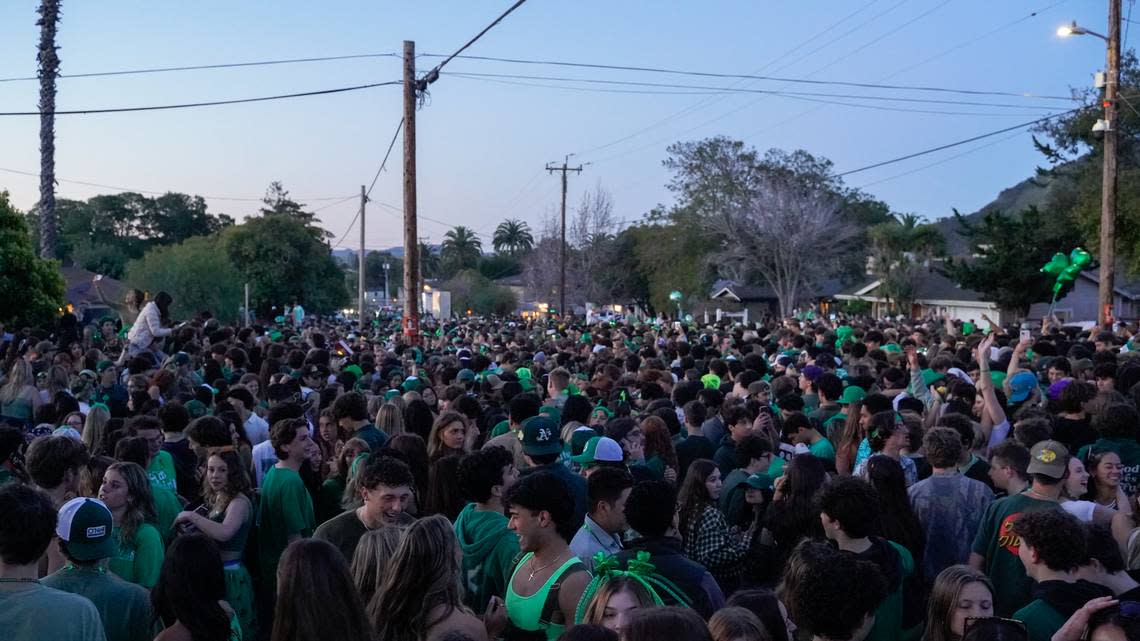Their home was trashed by St. Fratty’s Day partiers. Now the city is fining them? | Opinion

Someone should have to pay for the violations and vandalism linked to St. Fratty’s Day partying at Cal Poly, but it shouldn’t be unwitting residents caught in the middle of the Saturday morning fracas.
Yet authorities are fining people who were trying to protect their property, according to accounts some residents gave to Tribune reporters.
Chloe Mickelsen, a fourth-year student at Cal Poly, said she and her roommates attempted to barricade the doors to their rented home on Hathway Avenue to keep partiers out, though there was still extensive damage to the property. They called the San Luis Obispo Police Department multiple times to report what amounted to a neighborhood invasion. Yet they still were hit with a noise and partying citation.
Samantha Avalos, another Hathway Avenue resident, told The Tribune that she and her roommates also played “home defense” but were unable to keep students from crashing through the door and climbing on the roof, doing serious damage — including knocking out their internet connection.
Avalos said she wasn’t fined, but other residents on the street were stuck with $1,700 citations issued by the city.
That amounts to insult on top of injury.
Residents who were trying to keep the revelers out — rather than inviting them in — are in no way to blame for what happened. They deserve sympathy for what must have been a frightening and stressful experience, not a fine. The city needs to straighten out that injustice as quickly and painlessly as possible.
The situation at Muir Hall, the Cal Poly dorm that was so badly trashed students had to be evacuated, also deserves a review.
Under Cal Poly’s housing policy — which many other universities share — when a dorm is vandalized, all students must pay for repairs unless the actual culprits are identified. The minimum charge per resident is $5, but depending on the damage, it can run higher. According to the 2024 rate schedule, damaging a television costs $1,500, tampering with a fire extinguisher, $1,000, and damaging a desk, up to $600.
Muir Hall residents who spoke to a Tribune reporter doubted that the actual vandals would ever be found.
“Most of the kids that were breaking stuff were not residents,” said first-year student Wan Roothman.
There’s something inherently unfair about sticking students — and their parents — with a bill when they had nothing to do with the crime.
The same goes for fining residents who happen to live in a party zone that’s overrun by young people who climb on top of roofs, force their way past gates and crowd onto porches — all without permission.
As we’ve said before, relying on fines to discourage partying is not going to cut it — especially when it targets the wrong people.
The city of SLO and Cal Poly need to take a hard look at what happened this year and develop a plan to prevent a repeat in 2025 — one that includes a lot more security both on campus and in the neighborhoods.
They might also check with how other universities have handled the issue.
Chico State — a California university with its own “party school” reputation — also had a problem with out-of-control partying around St. Patrick’s Day. It responded by scheduling spring break in mid-March — the same time as St. Patrick’s Day — so that fewer students would be in town.
There is one hitch: Chico is on the semester system, while Cal Poly is on the quarter system.
However, Poly is scheduled to switch to semesters in the fall of 2026.
When that happens, it might consider scheduling a break in March — right around St. Patrick’s Day.

